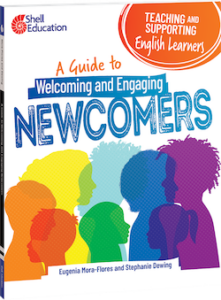5 Tips to Welcome and Engage Our Newcomers
By Stephanie Dewing
 Schools across the country have seen a recent influx of newcomer students from across the world. Newcomers are students who were born outside of the U.S. and have recently arrived here, usually within the last year or two. Their circumstances and lived experiences are diverse and unique.
Schools across the country have seen a recent influx of newcomer students from across the world. Newcomers are students who were born outside of the U.S. and have recently arrived here, usually within the last year or two. Their circumstances and lived experiences are diverse and unique.
What they have in common, though, is that they are new to the country, the language, the culture, and the school system.
While I acknowledge the challenge that many educators face when it comes to meeting the needs of newcomer students, my reaction is: Fantastic! This is the group of students I have worked with most closely over the years, and they hold a very special place in my heart.
Drawing upon some commonalities of the newcomer experience, I want to share what I believe are five best practices for welcoming and engaging this incredible population of young people into our classrooms.
1. Create a safe and welcoming environment.
► It has long been known how critical it is for students to feel safe and to have a sense of belonging (remember Maslow?). However, based on current brain research, we now know that if students feel unsafe, stressed or anxious, their ability to learn and process information is demonstrably inhibited.
Being a newcomer to the U.S. in and of itself can be traumatic. As the first faces they see when entering a school or classroom, it is essential for educators to be aware of that and provide a safe space with a welcoming atmosphere to ease that transition.
► Since the majority of human communication is nonverbal, we cannot underestimate the power of a smile and gestures. We all smile in the same language. Our students need to know that they are not only welcome, but that you are excited that they are there and that you believe in them and their success, even if they do not believe in that yet themselves.
► Why not label the classroom with all of the languages represented? This can be a fun class activity. Decorate your walls and fill your shelves with materials in which students can see themselves reflected, both culturally and linguistically. My walls always look their best when my students help decorate them. The same is true for the school and front office.
2. Get to know them (and their families).
There is so much power found within stories. When we take the time to get to know our students and families, their backgrounds, interests, and strengths, we are empowered to set them up for greater success. In fact, one of the most effective strategies we can implement in our classrooms is to connect new learning to something familiar. That is much easier to do when we know more about them.
Helping make those connections will not only strengthen content knowledge but will foster language development, too. In addition, getting to know their stories will provide opportunities for you to gain new insights and perspectives, which, in my experience, will result in you learning more than you ever imagined. What a privilege!
3. Take an assets-based approach to language development.
Being multilingual is truly a superpower. Sadly, many students have shared that they did not receive that message until later in life. First, we need to equip ourselves with the knowledge of the multitude of benefits that exist for those who know more than one language. Then, and most importantly, we need to shout that message from the rooftops to our students (and the world). This will likely lead to increased confidence, which often leads to increased engagement, which often leads to increased academic success.
4. Include strategies for both comprehensible input and output.
► Comprehensible input basically means that the content we highlight in class is accessible and understandable to our students. For those who are just beginning the process of learning English, here are a few simple tips for helping to make that content more accessible:
✻ First, offer visual and/or multimedia support, which provides context for the topics being addressed. This can come in the form of paper-based and/or electronic images or videos. Or, if you are artistically inclined, you can always draw images, too.
✻ Second, include manipulatives and engage in hands-on activities whenever possible. Many of us learn by doing, and even if students do not have all the words in English yet to be able to fully understand, being able to engage in an experience often brings that content to life.
✻ Third, allow for the use of first languages as appropriate for accessing content. This can be done via electronic apps/translators, bilingual dictionaries, or peer-to-peer collaboration.
✻ Finally, be mindful of the words you use and the speed at which you speak. Our students need time to process this new language!
► Comprehension often comes before production when we are learning language. That said, we want to find meaningful ways that students can practice English as soon as possible. Comprehensible output focuses on the structures in place to support the production of language in both speaking and writing.

In addition, identifying and emphasizing cognates (words that look and sound alike between the two languages) builds vocabulary (a.k.a word wealth) much faster.
✻ Second, including cue words and sentence frames can scaffold the syntax, or grammatical structure, of the English language. This is a relatively quick and easy linguistic scaffold we can provide.
✻ Third, get creative and be flexible with how students can demonstrate their understanding to you as they are in the process of developing more and more English. Consider their strengths when offering options, such as visualizing, creating a model, speaking about a topic, completing graphic organizers, etc.
✻ Finally, it’s essential to provide multiple opportunities in a low stakes environment to use the language. Consider the use of daily journals, partner and small group work, and games.
5. Have fun!
My final and possibly most important recommendation is to enjoy the journey! Reframe your mindset to focus on the fact that you “get to” welcome and engage newcomers and their families.
I have thoroughly enjoyed my experiences working with newcomers and have a deep admiration for all they go through. In fact, they inspire me every day. And so many of them have gone on to do the most incredible things after graduation.
In conclusion, one adult in the building can and does make a difference in these students’ lives. You get the chance to be that person. Embrace the opportunity and have fun along the way!
And visit our blog for an absolute goldmine of resources
by Tan Huynh & Valentina Gonzalez:
The Unstoppable ML Teacher

Stephanie is co-author (with Eugenia Mora-Flores) of Teaching and Supporting English Learners: A Guide to Welcoming and Engaging Newcomers (Shell Education, 2023) and supports educators across the country with strategies for welcoming, engaging, and teaching their multilingual and English learners across the curriculum.



































